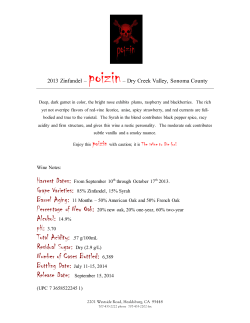
Georgia Comments to Fire Emissions in NEI2011
Georgia Comments to Fire Emissions in NEI2011 Di Tian, Tao Zeng, and James Boylan Georgia Department of Natural Resources Environmental Protection Division, Air Protection Branch EPA Fire Summit Research Triangle Park, NC November 3, 2014 1 Outline • Background • SMARTFIRE Estimates vs. GA EPD Estimates – – – – – Total emissions Spatial distribution Temporal distribution Fire counts and acres distribution by fire Fuel consumption values • Evaluating agriculture burning emissions in Georgia • GA EPD comments for U.S. EPA 2011 and 2018 emissions modeling platforms – Docket for 2011 Emissions Modeling Platform: www.regulations.gov/#!docketDetail;D=EPA-HQ-OAR-2013-0743 – Docket for 2018 Emissions Modeling Platform: www.regulations.gov/#!docketDetail;D=EPA-HQ-OAR-2013-0809 2 Background • Georgia Fire emissions inventory – There are a lot of fire activities in Georgia – Three NEI inventories: 2005, 2008 and 2011 fire emissions developed by GA EPD and submitted to U.S. EPA to include as part of NEI – Two SIP fire inventories: VISTAS2002 and SEMAP2007 • Georgia fire emissions in NEI2011 – 2011 burned records: Georgia Forestry Commission (GFC), military bases, USFS, and FWS (daily burned area for the Okefenokee area fire) – Shared these burning records with U.S. EPA and USFS – Reviewed SMARTFIRE estimates and U.S. EPA agriculture burning emissions – Developed GA estimates using the same method as used in the SEMAP2007 fire inventory development, no satellite data are used in the GA estimates • AMEC, 2012. Development of the 2007 Base Year and Typical Year Fire Emission Inventory for the Southeastern States Air Resource Managers, Inc. 3 Comparison of SMARTFIRE Estimates and GA EPD Estimates Emissions (tons/year) Difference (%) SMARTFIRE_draft SMARFIRE_v2 GA EPD SMARTFIRE_draft SMARFIRE_v2 Acres 2,349,116 2,034,861 1,686,655 39% 21% CO 1,761,852 1,450,815 981,215 80% 48% NH3 29,102 23,981 8,154 257% 194% NOX 33,575 28,530 38,888 -14% -27% PM10 187,746 155,390 152,840 23% 2% PM25 159,107 131,686 132,861 20% -1% SO2 16,156 13,574 10,663 52% 27% VOC 418,337 344,731 74,976 458% 360% 4 Emissions by Source Categories in Georgia during 2011 5 Spatial Distribution of Wildland Fire Emissions in NEI2011v1 Prescribed fires Wildfires • VOC emissions in NEI2011 look too high in all states except Georgia • Large difference in PM2.5 and NOx emissions between GA and AL/FL • Strangely low prescribed fire emissions in TX and low wildfire emissions in LA 6 Wildfires Prescribed fires Spatial Distribution of Burned Area in Georgia during 2011 7 Monthly Fractions of Prescribed Burning Areas SMARTFIRE_v2 has overestimated prescribed fire activities during October and November and underestimated such activity during March 8 Fire counts and acres distribution by fire 9 Fuel Consumption Values Used in 2011 SMARTFIRE_v2 for Prescribed Fires in Georgia VEG Urban Loblolly pine - Slash pine forest Longleaf pine / Turkey oak forest with prescribed fire Southern Coastal Plain dry upland hardwood forest Turkey oak - Bluejack oak forest Willow oak - Laurel oak - Water oak forest Chestnut oak - White oak - Red oak forest Red maple - Oak - Hickory Sweetgum forest fccs_ number Total Burned Area (acres) Percent of Burned Area Total number of fires Fuel consumption (tons/acre) min max 4.8 5.6 3.0 6.2 0.9 1.0 0 161 185 361,816 231,459 206,316 23.4% 15.0% 13.4% 7585 3085 2300 407 205,125 13.3% 2790 4.9 7.4 186 283 128,370 121,851 8.3% 7.9% 1932 1647 2.1 5.2 2.6 6.4 275 118,266 7.7% 1351 10.1 17.7 180 80,854 5.2% 720 5.5 19.8 • Most fuel consumption values look reasonable • Strange fuelbeds assigned in SMARTFIRE (e.g. urban) likely due to poor quality of lat/lon data for some fire records • Should set maximum fuel consumption value by fuel types – Prescribed fires are usually conducted every 2~5 years in the southeast • GA EPD 2011 /SEMAP2007 Fire inventory – NFDRS fuel type – 0.6~8.1 tons/acres for Georgia prescribed fires 10 Agriculture Burning Emissions in Georgia • Reviewed EPA agriculture burning emissions in Georgia • Burned area is less than that in GFC records • Developed GA EPD estimates using the same EFs used in EPA estimates • Submitted new estimates to EPA 11 Summary • SMARTFIRE_v2 estimates which include state/local fire burning records are better than SMARTFIRE_draft • VOC, CO and NH3 emissions for Georgia wildland fires are overestimated in SMARTFIRE_v2 – VOC emissions in SMARTFIRE are almost 5 times of the GA EPD estimates • Satellite fire detection data are not recommended to be used to develop wildland fire inventories in the southeastern U.S. when detailed local wildland fire data are available – Southeastern wildland fires are usually small and under canopy prescribed fires with short duration – Fire size/temporal/spatial distributions • Fuel consumption calculation should be updated for the southeastern U.S. • Emission factors for VOC, CO and NH3 should be examined • Local records for agriculture fires should be used 12
© Copyright 2025













